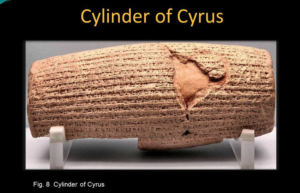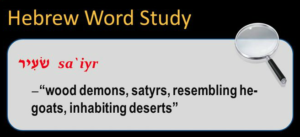The Fall of Babylon vs. The Destruction of Babylon
Read first: Is the Destruction of Babylon a Literal Event?
There are two main views regarding the fulfillment of the prophecies regarding the City of Babylon. View one—which you will find in most Bible helps—is that it occurred when Babylon fell to Cyrus the Persian in 539 BC. This misconception has likely occurred because the details of the various passages describing the destruction of Babylon are either ignored, spiritualized, allegorized or the passages are not being studied in context and compared with each other. View two is that it is still a future event and will occur near the end of the Tribulation
Revelation is a unique book that can be hard to understand when studied in isolation from the rest of Scriptures. “The Book of Revelation has no direct quotations from the Old Testament, but it has about 550 references back to the Old Testament. The majority of the things found in the first twenty chapters of the Book of Revelation are found elsewhere in the Old Testament. Only the last two chapters deal with things totally new.” (Fruchtenbaum 10)
So the Old Testament is basically the code book, the key to unlocking the meaning of the book of Revelation. To determine whether or not the first view that the destruction of Babylon occurred when Cyrus took the City of Babylon is the correct view, we will compare the historical details with those in Scripture.
Has the destruction of Babylon been fulfilled in History?
Cyrus Conquers Babylon
The attack by Cyrus and his armies against the City of Babylon was not a surprise attack, they knew of his relentless acts of aggression on nation after nation. The Babylonians had taken the precaution of storing enough provisions to last many years. When Cyrus approached Babylon, the Babylonian armies were in the field (outside of the city) waiting his approach and they ambushed him. But the Babylonians were defeated and forced to retreat. (Herodotus 1:190)
As the siege raged on, Cyrus was beginning to give up hope. Then, a plan was suggested (or, he thought of it himself) to station part of his forces at the point where the Euphrates flowed into the city. Another group were stationed at the opposite end where the river flows out. (191)
Herodotus describes what happened next.
When he came to the lake, Cyrus also did the same things which the queen of the Babylonians had done as regards the river and the lake; that is to say, he conducted the river by a channel into the lake, which was at that time a swamp, and so made the former course of the river passable by the sinking of the stream.
When this had been done in such a manner, the Persians who had been posted for this very purpose entered by the bed of the river Euphrates into Babylon, the stream having sunk so far that it reached about to the middle of a man’s thigh. The Persians came upon them unexpectedly; and owing to the size of the city (so it is said by those who dwell there) after those about the extremities of the city had suffered capture, those Babylonians who dwelt in the middle did not know that they had been captured; but as they chanced to be holding a festival, they went on dancing and rejoicing during this time until they learnt the truth only too well. Babylon then had thus been taken for the first time.
Notice how Herodutus assumes the festival that they were holding was simply by chance. The Bible describes the occasion of this festival in Daniel 5:1-2:
Belshazzar the king made a great feast to a thousand of his lords, and drank wine before the thousand. Belshazzar, while he tasted the wine, commanded to bring the golden and silver vessels which his father Nebuchanezzar had taken out of the temple which was in Jerusalem; that the king, and his princes, his wives, and his concubines, might drink therein. They drank wine, and praised the gods of gold, and of silver, of brass, of iron, of wood, and of stone.
While they were celebrating, they suddenly saw a disembodied hand writing on the wall of the palace over by a lightstand.
It said “Mene, Mene, Tekel, Upharsin.” Daniel was summoned to interpret it. “Mene” meant: God hath numbered thy kingdom, and finished it. “Tekel” meant: Thou art weighed in the balances, and art found wanting, and “Peres” meant: Thy kingdom is divided, and given to the Medes and Persians. (Upharsin and Peres are from the same root word.).
None of this was coincidence. Cyrus taking Babylon was God’s judgment on Babylon. So Cyrus conquered Babylon without a battle, there was no destruction and no one was killed within the city.
This is verified by the cylinder or steel of Cyrus which is displayed in the British Museum in London.
The following is a translation of a section describing the invasion of Cyrus and his armies into Babylon, but ascribing his success to the god Marduk.
Marduk, the great lord, guardian of his people, looked with gladness upon his (Cyrus’) good deeds and upright heart. He ordered him to go to his city Babylon. He set him on the road to Babylon and like a companion and a friend, he went at his side. His vast army, whose number, like water of the river, cannot be known, marched at his side fully armed.
He made him enter his city Babylon WITHOUT fighting or battle; he saved Babylon from hardship. He delivered Nabonidus, (Belshazzar’s Father) the king who did not revere him, into his hands. All the people of Babylon, all the land of Sumer and Akkad, princes and governors bowed to him and kissed his feet. They rejoiced at his kingship and their faces shone.
So, did this fulfill the prophecy regarding the destruction of Babylon? The most important details we need to compare to are those related to the actual physical destruction of Babylon. So, let’s compare them. Were the walls thrown down? (Jer. 50:15). Was the broadest wall of Babylon completely leveled? (Jer. 51:44, 58). Was its high gate set on fire? (Jer. 51:58); Were the bars of the gates broken? (Jer. 51:30). Did the pillars fall down? (Jer. 50:15). Were the buildings set on fire? (Jer. 51:30). Did Cyrus set fire to the city? (Jer. 50:32). Were the marshes burned with fire? (Jer. 51:32).
I think you will agree that none of these details were fulfilled when Cyrus conquered the city. Cyrus declared himself as the king of Babylon, and Babylon became the capital of the 9th Satrapy, which was the area of Babylonia in the South, and Athura in the North.
“I am Cyrus, King of the globe, great king, mighty king, King of Babylon….When I well disposed, entered Babylon, I had established the seat of government in the royal palace of the ruler, amidst jubilation and rejoicing. Marduk the great god, induced the magnanimous inhabitants of Babylon to love me, and I sought daily to worship him when my numerous soldiers in great numbers peacefully entered Babylon and moved about undisturbed in the midst of Babylon, I did not allow anyone to terrorize the people of the lands of Sumer and Akad.”
So, if the destruction of Babylon did not occur when Cyrus conquered it, what about Alexander the Great? As you will see, he ALSO conquered Babylon without a Battle! In fact, they welcomed Alexander with open arms and gifts!
Alexander the Great Conquers Babylon
Quintus Curtius Rufus who wrote from 41-54 AD described what happened next. “Moving on to Babylon, Alexander was met by Mazaeus, who had taken refuge in the city after the battle. He came as a suppliant with his grown-up children to surrender himself and the city.” (Rufus 5 1:17)
Mazaeus was “an eminent man and a good soldier who had also won distinction in the recent battle.” Alexander was pleased about this because his “example was likely to induce the others to surrender.” And he knew that taking the City of Babylon by force would have been a “long, arduous task.” So, Alexander gave him and his children a curteous welcome.
Not to be outdone by Mazaeus in paying his respects to Alexander, Bagophanes had carpeted the whole road with flowers and garlands and set up at intervals on both sides silver altars heaped not just with frankincense, but with all manner of perfumes.
Following him were his gifts—herds of cattle and horses, and lions, too, and leopards, carried along in cages. Next came the Magi chanting a song in their native fashion, and behind them were the Chaldeans, then the Babylonians, represented not only by priests but also by musicians equipped with their national instrument…At the rear came the Babylonian cavalry, their equipment and that of the horses suggesting extravagance rather than majesty.
The next day, Alexander entered the palace and inspect Darius’ (III) furniture and treasure. Babylon at this time became at least a secondary capital for the Medo-Persain Empire.
Rufus then describes how Alexander inspected the wall which was “constructed of small baked bricks and is cemented together with bitumen. The wall is thirty-two feet wide and it is said that two chariots meeting on it can safely pass each other.” (Rufus 5 1:25). So, obviously, the wall was still in place and had not been destroyed.
Years later, at the end of his career, Alexander began “by dredging operations…the construction of a harbor at Babylon.” (Arrian 7:19) It was large enough for 1,000 warships and it was equipped with yards. A yard is “a cylindrical spar, tapering to each end, slung across a ship’s mast for a sail to hang from.” The fact is, Alexander had ideas of settling the seaboard of the Persian Gulf and the off-shore islands, for he fancied it might become as prosperous a country as Phoenecia.
While the new warships were under construction and the work of dredging the harbor proceeded, Alexander sailed from Babylon down the Euphrates to the river known as Pallacopas, about 100 miles down-stream from the city.” So, he had not just planned a harbor, but had actually begun work on it.
After Alexander’s death, his successors fought over the City of Babylon to the point that the residents fled. By the time the Parthian Empire rule in 141 BC, Babylon had been deserted and forgotten. The city steadily fell into ruin and never returned to its former greatness. In the Muslim conquest in 650 AD, whatever remained of Babylon was swept away and was eventually buried underneath the sand. (Ancient Babylon)
It is evident that the City of Babylon was never destroyed in the manner described in Scripture. Therefore, in order for it to be destroyed in the manner described, it must first be rebuilt!
There are additional details regarding the destruction of Babylon that necessitate a future destruction of Babylon. The first of which is that it occurs during the Day of the Lord which the so-called seven year tribulation period)
In every passage of the Scriptures that the term ‘the Day of Jehovah’ or the ‘the Day of the Lord’ is found, it is always and without exception a reference to the Tribulation period. While the phrase “that day” is used both negatively and positively and therefore many times it does apply to the Millennium, the phrase Day of Jehovah or Day of the Lord is always used negatively and never included the Millennial Kingdom. (Fruchtenbaum 173)
The prophecy in Isaiah 13:1 begins with “A message that Amoz’s son Isaiah received about Babylon.” God then calls his sanctified ones and his mighty ones to prepare for battle. They come from a far country (the land of the North) to destroy the whole land.
“Wail out loud, because the Day of the Lord is near. It will come like destruction from the Almighty!” And verse 9 “Watch out! The Day of the Lord is coming—cruel, with wrath and fierce anger—to turn the entire inhabited earth into a evolution and to annihilate sinners from it.”
Verse 10 describes the final cataclysmic events “The stars of heaven and the constellations shall not give their light. The sun shall be darkened and the moon shall not cause her light to shine.” Obviously, the Day of the Lord has not occurred yet, so the destruction of Babylon must occur in the future. Next, Israel is in the land and forgiven. Currently, Israel is in the land, but in unbelief, however, this will change near the end of the tribulation.
Jeremiah 50:15 states;
Behold, I will punish the king of Babylon and his land…But I will bring back Israel to his habitation, and he shall feed on Carmel an Bashan; His soul shall be satisfied on Mount Ephraim and Gilead. In those days, and in that time, sayeth the Lord, the iniquity of Israel shall be sought, but there shall be none; and the sins of Judah, but they shall not be found; for I will pardon those whom I preserve.
And thus as Romans states in 11:26 “And so all Israel shall be saved.” The sins of the remnant will be pardoned. This only occurs during the last three days of the tribulation (Hosea 5:15, 6:1-2)
Jesus cannot come back until Israel confesses her national sin of rejection of the Messiah and pleads for him to return (Fruchtenbaum 331).
Next is the use of smart weapons, which did not exist in the past, and currently are not 100% accurate. At some point, though, certain weapons will be 100% accurate or at least will be with God’s assistance.
Regarding the weapons of the multitudes of nations which will come from the land of the North. Jeremiah 50:9 states that “Their arrows will be like a skilled warrior; they won’t miss their targets.” And as Chuck Missler has pointed out, it is the arrow itself that has the intelligence. This is something that can’t be said of a traditional arrow. The Hebrew word “chets” is simply an arrow and in the Greek Septuagint, it is “bolis,” a missile, arrow or javelin. Think about it, how would you describe a weapon that doesn’t even exist yet? No one uses actual bows and arrows in modern warfare. But the concept of an arrow is still used. It could legitimately be ascribed as a projectile, and a bow is something that launches the projectile.
One of the most definitive statements that indicate that the destruction of Babylon is still a future event is Jeremiah 51:26 that makes it clear that the building materials will never be reused. “And they shall not take of thee a stone for a corner, nor a stone for foundations; but thou shalt be desolate forever, saith the Lord.”
However, the original building materials HAVE been reused. In 1983, Saddam Hussein started rebuilding the City of Babylon on top of the old ruins. He built on the old bricks with new bricks of his own which he inscribed with: “This was built by Saddam Hussein, son of Nebuchadnzzar, to glorify Iraq.” You can see in this photo where the original bricks are and where the new bricks were built directly on top of them.

The only conclusion can be that in order for this prophecy to be fulfilled, the City of Babylon must be rebuilt and become a major trade center (Rev. 19) in order to be destroyed in the manner described in Scripture.







